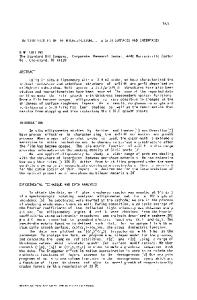Chemistry at Polyimide-Metal Interfaces: In Situ FTIR Studies of Polymer Curing Processes and Thermal Stability
- PDF / 407,779 Bytes
- 6 Pages / 420.48 x 639 pts Page_size
- 35 Downloads / 408 Views
CHEMISTRY AT POLYIMIDE-METAL INTERFACES: IN SITU VTIR STUDIES OF POLYMER CURING PROCESSES AND THERMAL STABILITY JIONG-PING LU, DAVID VOLFSON, FRED TRUSELL and KLAVS F. JENSEN Electronics Packaging Program and Departments of Chemical Engineering and, Electrical Engineering and Computer Science Massachusetts Institute of Technology Cambridge, MA 02139 ABSTRACT We report in-situ Fourier transform infrared (FTIR) reflection-absorption studies of curing chemistry of polyirnide thin films on Cr and Cu surfaces, and of the thermal stability of the resulting thin film interfaces when exposed to air at elevated temperatures. The polyimide investigated is based on 4,4'-(hexafluoroisopropylidene)bis(phthalicanhydride)-4,4'-bis(4aminophenoxy)-biphenyl. The imidization process takes place at temperatures higher than 90*C and a small amount of anhydride is generated during curing. This by-product is 0 converted to imide at temperatures above 250 C. Complete imidization is achieved after curing at 300*C on Cr substrates, while evidence for incomplete curing on Cu is observed under the same conditions. Thermal stability studies with Cr and Cu substrates show that thermal decomposition of thin (-1000,) polyimide films occurs on Cu when the film is exposed to air at 200'C, while the polyimide is stable on Cr.
INTRODUCTION As advanced integrated circuits are pushed towards higher density and faster switching speed [1,2], fine lines and multilayer structures become necessary to accommodate the correspondingly large number of signal inputs and outputs. Since polymers are easily patterned, have high resistivity and low dielectric constants, they have rapidly become the materials of choice in multichip modules (MCM). Chemistry at polymer-metal interfaces in the MCM structure plays a critical role in fabrication, performance and reliability of the final electronics package. Polyimides are among the most widely applied polymer materials in electronics packaging because of their chemical and physical properties [3,4], specifically high thermal stability, low dielectric constant, ease of processing, excellent mechanical properties, and chemical stability. We investigate curing and interface reactions of a new fluorine containing polyimide based on the system 4,4'-(hexafluoroisopropylidene)bis-(phthalicanhydride) (6FDA)-4,4'bis(4-aminophenoxy)biphenyl (APBP) through the use of Fourier transform infrared spectroscopy (FTIR). This technique has advantages for monitoring chemistry of polymermetal interfaces since it directly probes polymer functional groups [5]. As an optical technique, FTIR does not require a vacuum environment, and it may be configured to characterize interfaces under actual processing conditions. Previous investigations have demonstrated the utility of FTIR in monitoring polymer curing processes and effects of curing environments. These studies have typically been conducted by in-situ IR transmission of thick polymer films deposited on IR transparent substrates [6-8], while in-situ IR characterization of the curing of thin p
Data Loading...










